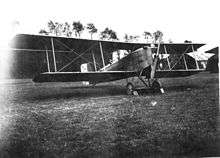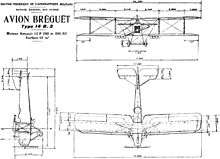Breguet 14
| Breguet 14 | |
|---|---|
 | |
| Polish Breguet 14 during the Kiev Offensive | |
| Role | Bomber |
| Manufacturer | Breguet |
| Designer | Marcel Vuillierme |
| First flight | November 21, 1916 |
| Introduction | 1917 |
| Primary users | Aéronautique Militaire US Army Air Service Polish Air Force Royal Thai Air Force |
| Produced | 1916-1928 |
| Number built | ca 7,800 |
|
| |
The Breguet 14 was a French biplane bomber and reconnaissance aircraft of World War I. It was built in very large numbers and production continued for many years after the end of the war. Apart from its widespread usage, it is known for being the first mass-produced aircraft to use large amounts of metal rather than wood in its structure. This allowed the airframe to be lighter than a wooden airframe of the same strength, in turn making the aircraft very fast and agile for its size, able to outrun many of the fighters of the day. Its strong construction was able to sustain much damage, it was easy to handle and had good performance. The Breguet 14 is often considered to have been one of the best aircraft of the war.
Design and development
The aircraft was designed by Louis Breguet, who flew the first prototype (originally designated "Breguet AV Type XIV") on its first flight on 21 November 1916. The design was a return for Breguet to designing conventional planes, after designing the pusher-type Breguet BUM. Later that month, the French Army's Section Technique de l' Aéronautique (S.T.Aé.) issued requirements for four different new aircraft types. Breguet submitted his new design for two of those categories - reconnaissance aircraft, and bomber.
Following evaluation in February, the Breguet 14 was accepted for both these roles, and in March, orders were placed for 150 reconnaissance aircraft and 100 bombers, designated "Breguet 14 A.2" and "14 B.2" respectively (by 1918 written Breguet XIV A2/B2). The A.2s were equipped with cameras, with some carrying radios, while the lower wing of the 14 B.2 was modified slightly in order to accommodate bomb racks (built by Michelin). Both variants featured automatic, bungee cord-operated aerodynamic flaps, but these were not fitted to production aircraft. A number of B2 models were equipped with the U.S.-built Liberty engine and were denoted "Breguet 14 B2 Ls".
Other minor variants flown in small numbers during the war included the 14 B.1 long-range single-seat bomber, the 14 GR.2 long-range reconnaissance, the 14 H floatplane, the 14 S air ambulance and the 14 Et.2 trainer. Later variants 14bis A2 and 14bis B2 featured improved wings. An improved variant with bigger wings was the 16. There was also the two-seat fighter 17, which was built in small numbers only.
Operational history

Following successful deployment by the French, the type was also ordered by the Belgian Army (40 aircraft) and the United States Army Air Service (over 600 aircraft). Around half the Belgian and U.S. aircraft were fitted with Fiat A.12 engines due to shortages of the original Renault 12F. By the end of World War I, some 5,500 Breguet 14s had been produced.
The type continued to be widely used after the war, equipping the French occupation forces in Germany and being deployed to support French troops in the colonies. A special version was developed for the harsh conditions encountered overseas, designated "14 TOE" (Théatres des Operations Extérieures). These saw service in putting down uprisings in Syria and Morocco, in Vietnam and in France's attempted intervention in the Russian Civil War. The last trainer examples were not withdrawn from French military service until 1932.
Other air arms using the type included Brazil (30), China (70), Czechoslovakia (10), Denmark, Finland (38), Greece, Japan, the Siamese Air Force, Uruguay (9) and Spain. The Polish Air Force used 158 Breguet 14s, about 70 of them being used in combat in the Polish-Soviet war. In Japan, Breguet 14s were licence-built by Nakajima.
Postwar, Breguet had also begun to manufacture dedicated civil versions. The 14 T.2 Salon carried two passengers in a specially modified fuselage. An improved version of this was the 14 Tbis, manufactured as both a land-plane and seaplane.[1] The 14 Tbis also formed the basis of the improved 14 Tbis Sanitaire air ambulance version, and 100 mail planes custom-built for Pierre Latécoère's fledgling airline, Lignes Aeriennes Latécoère. After changing its name to "CGEA", the airline used, among others, 106 Breguet 14s for flights over the Sahara Desert. The 18 T was a single 14 T re-engined with a Renault Ja engine and equipped to carry four passengers. When production finally ceased in 1928, the total of all versions built had reached 7,800 (according to other sources, 8,000 or even 8,370).
Operators
- Compañía Franco-Argentina de Transportes Aéreos SA
- Aeroposta Argentina
- Estonian Air Force operated one aircraft only.
- Lithuanian Air Force operated two aircraft
- Iranian Air Force received two aircraft
- Paraguayan Air Arm - one aircraft used in the Revolution of 1922
- Swedish Air Force received one aircraft only
Specifications (14B.2)

Data from {name of first source}
General characteristics
- Crew: two
- Length: 8.87 m (29 ft 1 in)
- Wingspan: 14.36 m (47 ft 1 in)
- Height: 3.30 m (10 ft 10 in)
- Wing area: 47.50 m² (511 ft²)
- Empty weight: 1,010 kg (2,227 lb)
- Max. takeoff weight: 1,536 kg (3,386 lb)
- Powerplant: 1 × Renault 12Fe, 224 kW (300 hp)
Performance
- Maximum speed: 190 km/h (95 kn, 109 mph)
- Range: 900 km (486 nmi, 560 mi)
- Service ceiling: 6,000 m (19,685 ft)
- Rate of climb: 292 m/min (960 ft/min)
- Wing loading: 32 kg/m² (at max. takeoff weight) (6.6 lb/ft²)
- Power/mass: 145 W/kg (at max. takeoff weight) (0.09 hp/lb)
Armament
- Guns: 1 × fixed 7.7 mm (.303 in) Vickers machine gun
- 2 × flexible 7.7 mm (.303 in) Lewis Gun for observer
- Bombs: 300 kg (660 lb)
See also
- Related development
- Aircraft of comparable role, configuration and era
- Related lists
References
| Wikimedia Commons has media related to Breguet 14. |
- Taylor, John W. R., and Jean Alexander. "Combat Aircraft of the World" London: George Rainbird Ltd, 1969 Pg.74-75 Library of Congress Catalog Card Number 68-25459
- Tomasz J. Kowalski, Samolot Breguet 14, TBiU no.197, Warsaw 2002, ISBN 83-11-09461-6 (Polish language)
- ↑ "1921 Paris Air Salon: Breguet 14Tbis" FLIGHT, November 24th 1921, side-view drawing